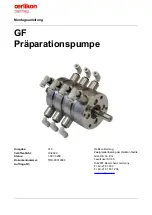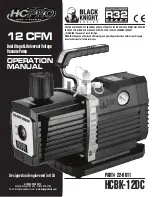
WIK USER INSTRUCTIONS ENGLISH BO2662 5/09
Page 19 of 76
2) Clean off foundation slab and follow epoxy
manufacturer's instructions for any further
preparation of the slab.
3) Wrap cloth around leveling screws to cover
threads, thereby leaving space for loosening the
leveling screws.
Proper practice is to begin grouting lowest
compartment, which is normally at pump end of
baseplate, and progress in order to highest
compartment, which is normally at driver end of
baseplate.
4) In accordance with the epoxy manufacturer's
instructions apply grout through grout holes in
baseplate (soleplates too, where holes have
been provided).
5) Before epoxy grout is set but after it is apt to
flow, remove cloth from around foundation bolts,
exposing threads.
6) Allow epoxy grout to set for period specified by
epoxy manufacturer, then:
a) Remove cloth from around foundation bolts,
back off leveling screws until completely free
of baseplate (or soleplates) and tighten hold
down nuts on foundation bolts or
b) Leave leveling blocks and shims in plate and
tighten hold down nuts on foundation bolts,
whichever is applicable.
7) Complete step 9 under section 4.4.1 above.
4.5
Initial alignment
4.5.1 Alignment tools and equipment
In addition to hand tools, the pump-to-driver
alignment task requires:
1) Hoisting equipment
2) Two dial indicators
3) Double dial indicator bracket
4) Precision machinist level or equivalent tool
4.5.2 Alignment accuracy
The alignment of the pump and driver must be
accurate. A flexible coupling is not a universal joint
and must be aligned with the same care and
accuracy as a rigid coupling. Misalignment will cause
noise, shaft vibration, hot bearings, and rapid wear
of bearings, bushings, rings and packing, and may
cause the rotating element to seize. To assure that
the pump and driver are in accurate alignment, their
shafts must be checked for alignment and corrected,
if necessary, and the hold down bolts tightened
under these circumstances:
1) After the baseplate or soleplate(s) has been
grouted in at its permanent installation.
2) After connecting the plant's piping to the pump.
3) After the first run, with the pump still hot from
several hours of operation, with incoming liquid
at its normal temperature, and before the pump
goes on line for an extended period.
4) After the first slight increase in vibration appears
following a long period in service or after a
sudden increase in vibration.
4.5.3 Reasons for field alignment of pump and
driver
Although in some cases Flowserve does ship the
driver mounted on the baseplate with the pump, the
driver shaft is not precisely aligned with the pump
shaft; thus, such shipments, as well as those where
pump and driver are packed separately, must be
field-aligned before operating the pump. Flowserve's
principal reasons for not factory-aligning the pump
and driver are:
1) Driver mount pads should be empty for leveling
baseplate (see section 4.3.1).
2) Distortion of the baseplate may occur as a result
of handling during shipment or unloading.
3) Minor distortion in the baseplate may occur
when it is bolted to its own foundation, which in
turn may produce some misalignment between
pump and driver if they are aligned and coupled
before the baseplate is leveled and anchored on
its foundation.
4) Alignment adjustment may be required to
compensate for the strain on the pump and the
baseplate that may be imposed by loads
transmitted from the plant's system via the
suction and discharge piping.
5) The factory alignment of a pump would be
performed at an average temperature of 24°C
(75°F). Since operation of a pump at a different
temperature would cause alignment changes
due to thermal effects on the pump's pedestal
position, final alignment must be made with the
pump and driver at their actual operating
temperature.
4.5.4 Alignment preconditions
To make the alignment tasks easier and to prevent
pump and driver from working into a state of
misalignment, before starting the tasks, you should
make certain:
1) That baseplate or soleplate(s) is level and
anchored (see section 4.3.1).
2) That baseplate or soleplate(s) is properly
grouted (see section 4.4).
3) That cradle, where applicable, has been leveled
to soleplate, using vertical leveling screws and
precision machinist level or equivalent tool.
















































